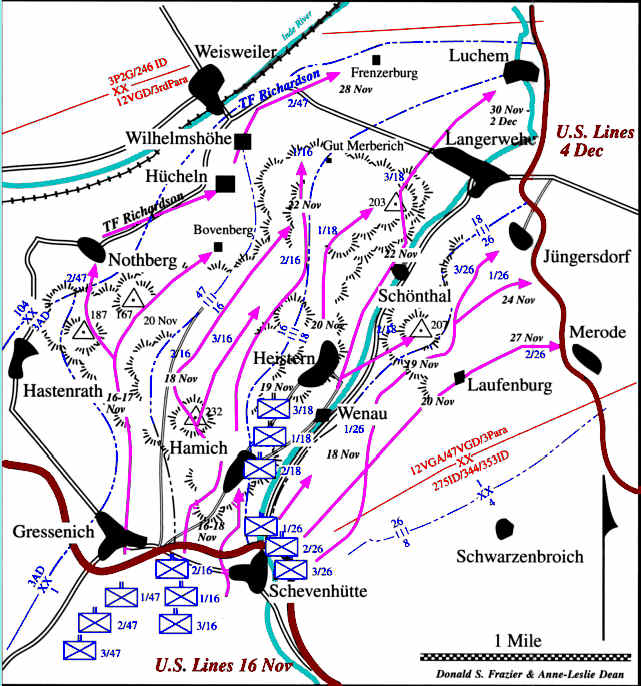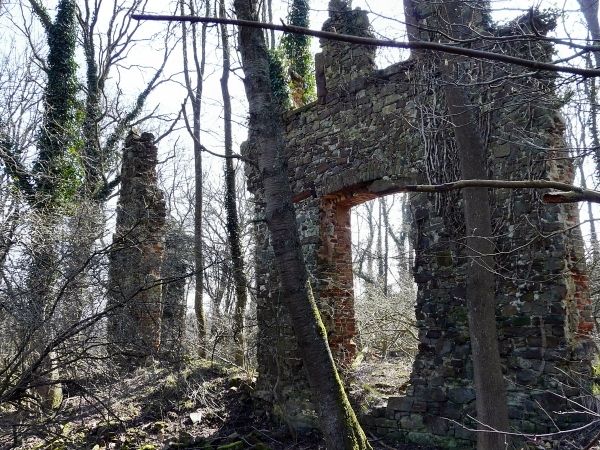(1st Infantry Division) in the Attack on the Hürtgen Forest
16 November - 5 December 1944
(Rhineland Campaign)
By Major Maurice A. Belisle
NARRATION ctnd.
Because of the nature of the terrain and the aggressive enemy a tight allaround defense was now more essential than ever. Defensive fire plans were a priority. It was extremely important that units report their exact locations at all times - especially so when requesting artillery fire. As it was the artillery was experiencing a certain amount of difficulty in giving troops close support because the extreme seasonal dampness which was believed to be affecting accuracy some. Moreover the friendly and target areas were covered with trees of 75-100 foot heights requiring the artillery to fire extremely accurate high angle fire in close support to prevent casualties to our troops. (24)
Operations on 18 November followed pretty much the pattern of the previous two days. The 2d Battalion going north now was stopped again at the road junction of the secondary gravel road and the trail at Point #2 by enemy defenses simlar to those encountered the previous day. Again the platoon of engineers was called upon to rush the road reconstruction so that the tanks and TD's could be brought up to support the assault. Late in the day the tanks and TD's were brought up into position to support by fire. The coordinated attack jumped off after a short preparatory blasting of enemy installations by the self-propelled mounts, however, the battalion made little if any progress during the remainder of the day.
The 1st Battalion had jumped off at 0800 hours like the 2d going generally north parallel to the SCHEVENHÜTTE - LANGERWEHE ROAD. Again the battalion hit stiff opposition and made small gains. The battalion holed up for the night 200 yards north of #272. (25) During the day the regimental commander ordered the 3d Battalion to move from its assembly area to occupy positions vacated by the 1st Battalion that morning. The battalion commander was called to the regimental CP to receive the order for his battalion's attack on the following day. It was the intent of the regimental commander that the 3d Battalion pass through the 2d Battalion as soon as the enemy were cleared from the road junction. The road north from that point appeared to be capable of supporting armor even at this season. Moreover it was felt that if the 3d Battalion could move as soon as the 2d Battalion had cracked this line the shock action of a fresh Battalion reinforced with a platoon of tanks and a platoon of TDs might force a deep wedge into the enemy line. (26)

Situation Map - 1st Infantry Division, November - December 1944
Map source: "A Dark and Bloody Ground ", book by Edward G. Miller
On the following morning the 2d Battalion successfully attacked the positions at the junction. The 3d Battalion spearheaded by tanks moved through the 2d Battalion. By 1600 hours it had taken its objective, the high ground and road junction east of LAUFENBERG (Point #3), by-passing the castle itself. Meanwhile the 2d Battalion was ordered to hold its positions to protect the regiments right flank. At the time the regiment had no contact with the unit on the right except by patrol. About 1800 hours E Company on the 2d Battalion right received a counterattack from the right flank which it repelled with well placed mortar and artillery fire. Apparently all units in the division were facing extremely heavy opposition and were making maximum use of their supporting fires. Division artillery reports firing 200-300 missions daily during this period. (27) The 1st Battalion, continued with its mission on the left flank keeping abreast of and in contact with the 16th Infantry. (28) The regimental picture was brighter than it had been since the offensive opened. The 3d Battalion gains showed a deep salient pushed into enemy territory, but the regiment was now entirely committed with its right flank open. The cost of ground gained had been extremely heavy in manpower casualties had sapped the strength of the 1st and 2d Battalions, especially so in key personnel. The problem of assimilating replacements in this situation was particularly difficult. All of the rifle companies were dangerously low in strength at one time or another during the drive, moreover those units needing reinforcements most were necessarily in contact and under fire. When the regiment was notified that replacements were available they were picked up at division and brought to the regimental rear CP where the regimental Executive Officer met and received them. There he saw to it that they had a hot meal and were properly clothed and equipped to join their units. They were then briefed on the Division and Regimental histories, on the type men they were to be with, or what to expect when they joined their companies, and all those things a newcomer should be acquainted with. Unfortunately they then were sent up to the Battalions, all of which were in line. It was impossible to get them to their companies in daylight - companies were generally attacking or in contact and under extremely heavy fire. At night when the Battalions had stopped and buttoned up the new men were brought to the company areas. Before they knew where they were the men were hustled to a foxhole or a site for one - to them it must have been a hell they never thought existed. As might be expected attrition was high among the newcomers. Many of them never made their first attack - their first night with a company in the line had cost them their lives or limbs. The 1st and 3d Battalions were ordered to move again at 0800 hours. The 1st Battalion again was moving west and north against heavy opposition to protect the left flank by clearing woods to SCHEVENHÜTTE road - contacting 16th Infantry. The 3d Battalion was moving north and east. As might be expected the Battalions eventually could no longer tie in and a gap developed between them. The regimental commander requested additional troops to cover the area between these units. The division commander made the Division reconnaissance troops immediately available and they were thrown into the line between the two rifle Battalions. As previously noted the 2d Battalion was still holding positions on the right flank north of the KLOSTER RUINS and was being probed by enemy patrols.

Ruins of the monastery Schwarzenbroich
The Battalion reported heavy casualties from the neverending artillery and mortar fire, every round a tree burst, which over an extended period was falling at the rate of 500 rounds per hour by count. Finally at 1225 hours, elements of the 115th Grenadier Regiment, hit the Battalion with a strong attack - but by now the Battalion was firmly entrenched and by darkness was still holding its own when the enemy was forced to withdraw. The 3d Battalion moved well initially and by 1100 hours was on the high ground east of LAUFENBURG and south of the trail into MERODE from which they had observation of certain ROER valley towns to the north. Throughout the day the 3d Battalion received extremely heavy artillery and mortar fire. (30) The enemy had evidently gotten a fix on them once they had stopped. That was one of the great penalties of fighting in woods - once stopped the enemy got an accurate location and literally showered the area with artillery and mortars. Not that moving troops received none - that was not the case. The amount of fire received in woods fighting (all things being equal) was relative to fixing the target and friendly troops. Conversely, an enemy being pushed closely and rapidly is unable to bring down indirect fires on the pursuer - he happened to be as thin-skinned as his target when on the move, toward his fatherland or elsewhere. At the end of the day the 3d Battalion held the high ground above and east of LAUFENBURG and positions across both roads running northeast and northwest about 1000 yards south of LAUFENBURG. The 1st Battalion held a line in the woods overlooking the north-south road extending from just south of HAMICH to the north for 1000 yards. Plans for the following day called for the 1st Battalion to pass through the 3d Battalion to take an objective in the vicinity of triangulation point 245 just west of MERODE, however Division insisted that the 1st Battalion remain in its present position in Division reserve because the 16th Infantry on our left had been receiving extremely heavy counterattacks.

